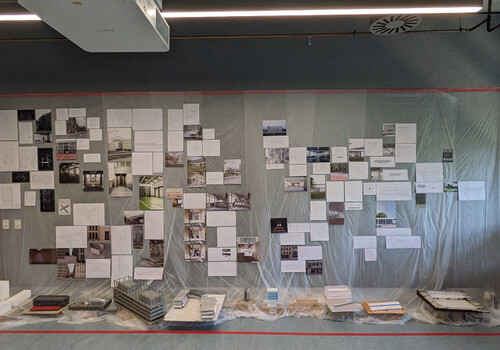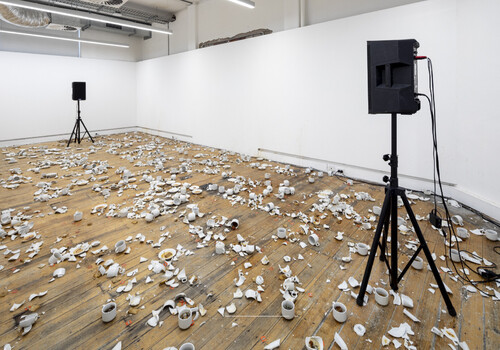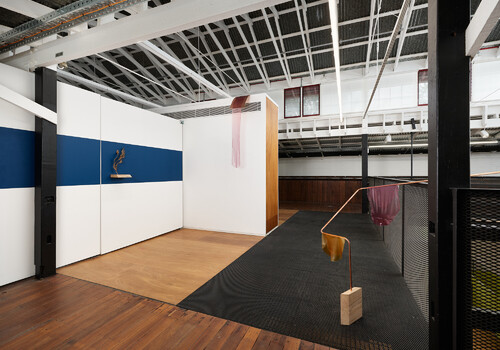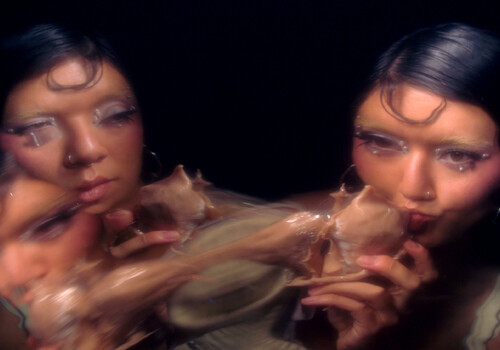Photomedia, Sculpture, Bachelor of Fine Art, National Art School
By Joshua Di Mattina-Beven
Confession: I got overwhelmed on opening night and looked at artworks on https://gradshow24.nas.edu.au/ (Powered by Shopify). Sacrilege, I know. But why not cut through the crowds and go directly to the source? As I scroll, I am drawn to works that defy commodification, listed on the website as “NFS” (Not For Sale). Graduating artists Alexandra Henley Yuen Wan Wong, Ruby Quoyle, and Chile Bainbridge seemingly resist the sale, drawing me from my commodified technosphere and into their playfully post-digital worlds.

Installation view of Alexandra Henley Yuen Wan Wong, Mind Palace, 2024, astroturf, screen, National Art School. Photo: Document Photography.
Inside the photo media galleries, I sit on a plush plinth upholstered in astroturf. Entering Alexandra Henley Yuen Wan Wong’s Mind Palace (2024) feels like a nostalgic trip into an artificial future. Shaky handycam videos are mapped onto a forced perspective, constructing a disorienting, dioramic room. Wong’s palatial inner world depicts moments in between artistic production: walks home, friends in the studio or doughnuts on lunch break. Inside the room, there is a cutout figure crudely dancing away. Bordering on absurd, the undulating video-scape creates a nauseating monument to digital nostalgia. The audience is not presented with a final product, rather we frolic through the mind and memory of Wong’s wandering eye.
Ruby Quoyle’s chair with a wig (affectionately named Tracy) stares at me with wide eyes and an even wider smile across the room of the sculpture department. I am trying to focus on another work, but can’t shake the feeling I am on the outside of a joke. I turn and find myself in a three way shoot out with Tracy and her spider-man-masked counterpart. Costume circumvents the function of the everyday object, slyly transforming them (and me) into Quoyle’s complicit performers. Performance appears again in Quoyle’s confessional tapestries. After an extended soliloquy on their love of the Toyota Carolla, a tapestry begins “I starte,” before trailing off. The works seem to be in-the-making, or rather unmade. In this sense, the personal becomes a conduit for other kinds of intimacy—an intimacy of multiple selves, refracted through costume, confession, and disguise.

Installation view of Ruby Quoyle, Tracy, 2024, chair, wig, cotton, stuffing, thread, National Art School. Photo: Document Photography.
Finally, I am rewarded for my IRL wandering. I am now engaged in a different kind of art consumption: I am eating banoffee pie. Chile Bainbridge instigates community building, opening discussions on gender and trans abstraction through recorded interviews, sculptural underwear, and video-performance. The pie is a welcome treat for my weary legs. It is made by Bainbridge’s friend, Milo, and includes a recipe card. The work’s refreshing earnestness captures a feeling of mutual reciprocity, or solidarity, between me, the artist, and the subjects. Milo and the interviewed participants do not feel captured by Bainbridge’s static frame (as photography often does). The multimedia site instead encourages continued engagement such that the subjects and I become co-participants in Bainbridge’s documentary project. I take home a recipe card with the promise of making a pie for myself, and my friends. If this is art collection, I’m into it.

Installation view of Chile Bainbridge, Milo’s banoffee pie//a recipe card, 2024, double-sided digital print, banoffee pie, National Art School. Photo: Document Photography.
I am most interested in how NAS creates the conditions for an art destined for commodity and collection. How can students evade this commodifying gaze? As they pass through the professionalising gates of the graduate exhibition, Wong, Bainbridge, and Quoyle offer ephemeral gestures dedicated to the power of everyday transformation. Their works brim with the kind of uncollectable, unmade, and unruly energy I expect from “emerging” artists. In this way, they sidestep NAS’s collect-a-thon. Perhaps it’s for the best, or I would be tempted to “add to cart.”
Joshua Di Mattina-Beven is an emerging artist and writer from Eora, Sydney.









































